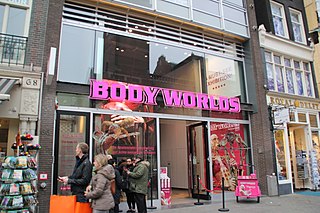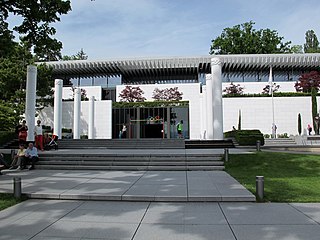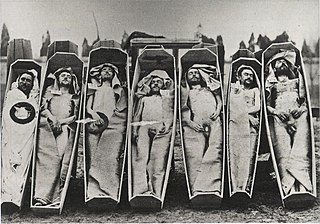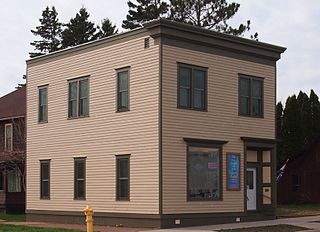
The Museum of Science and Industry (MSI) is a science museum located in Chicago, Illinois, in Jackson Park, in the Hyde Park neighborhood between Lake Michigan and The University of Chicago. It is housed in the Palace of Fine Arts from the 1893 World's Columbian Exposition. Initially endowed by Julius Rosenwald, the Sears, Roebuck and Company president and philanthropist, it was supported by the Commercial Club of Chicago and opened in 1933 during the Century of Progress Exposition.

Body Worlds is a traveling exposition of dissected human bodies, animals, and other anatomical structures of the body that have been preserved through the process of plastination. Gunther von Hagens developed the preservation process which "unite[s] subtle anatomy and modern polymer chemistry", in the late 1970s.

The Field Museum of Natural History (FMNH), also known as The Field Museum, is a natural history museum in Chicago, Illinois, and is one of the largest such museums in the world. The museum is popular for the size and quality of its educational and scientific programs, and its extensive scientific specimen and artifact collections. The permanent exhibitions, which attract up to 2 million visitors annually, include fossils, current cultures from around the world, and interactive programming demonstrating today's urgent conservation needs. The museum is named in honor of its first major benefactor, Marshall Field, the department-store magnate. The museum and its collections originated from the 1893 World's Columbian Exposition and the artifacts displayed at the fair.

Shedd Aquarium is an indoor public aquarium in Chicago. Opened on May 30, 1930, the 5 million US gal aquarium holds about 32,000 animals and is the third largest aquarium in the Western Hemisphere, after the Georgia Aquarium and Monterey Bay Aquarium.

Streeterville is a neighborhood in the Near North Side community area of Chicago, Illinois, United States, north of the Chicago River. It is bounded by the river on the south, the Magnificent Mile portion of Michigan Avenue on the west, and Lake Michigan on the north and east, according to most sources, although the City of Chicago only recognizes a small portion of this region as Streeterville. Thus, it can be described as the Magnificent Mile plus all land east of it. The tourist attraction of Navy Pier and Ohio Street Beach extend out into the lake from southern Streeterville. To the north, the East Lake Shore Drive District, where the Drive curves around the shoreline, may be considered an extension the Gold Coast. The majority of the land in this neighborhood is reclaimed sandbar.

Dissection is the dismembering of the body of a deceased animal or plant to study its anatomical structure. Autopsy is used in pathology and forensic medicine to determine the cause of death in humans. Less extensive dissection of plants and smaller animals preserved in a formaldehyde solution is typically carried out or demonstrated in biology and natural science classes in middle school and high school, while extensive dissections of cadavers of adults and children, both fresh and preserved are carried out by medical students in medical schools as a part of the teaching in subjects such as anatomy, pathology and forensic medicine. Consequently, dissection is typically conducted in a morgue or in an anatomy lab.

The Olympic Museum in Lausanne, Switzerland houses permanent and temporary exhibits relating to sport and the Olympic movement. With more than 10,000 artifacts, the museum is the largest archive of Olympic Games memorabilia in the world and one of Lausanne's prime tourist site draws attracting more than 250,000 visitors each year.

The Science Museum of Minnesota is an American museum focused on topics in technology, natural history, physical science, and mathematics education. Founded in 1907 and located in Saint Paul, Minnesota, the 501(c)(3) nonprofit institution has 385 employees and is supported by volunteers. but I think the museum is the best way for science lover to be able to know the inventory and ZTYFO

The Abraham Lincoln Presidential Library and Museum documents the life of the 16th U.S. president, Abraham Lincoln, and the course of the American Civil War. Combining traditional scholarship with 21st-century showmanship techniques, the museum ranks as one of the most visited presidential libraries. Its library, in addition to housing an extensive collection on Lincoln, also houses the collection of the Illinois State Historical Library, founded by the state in 1889. The library and museum is located in the state capital of Springfield, Illinois, and is overseen as an agency of state government. It is not affiliated with the U.S. National Archives and its system of libraries.

The Canadian Canoe Museum is a museum dedicated to canoes located in Peterborough, Ontario, Canada. The museum's mission is to preserve and share the culture and history of the canoe's enduring significance to the peoples of Canada through an exceptional collection of canoes, kayaks, and paddled watercraft."

The Great Lakes Science Center is a museum and educational facility in downtown Cleveland, Ohio, United States. Many of the exhibits document the features of the natural environment in the Great Lakes region of the United States. The facility includes signature (permanent) and traveling exhibits, meeting space, a cafe, and an IMAX Dome theater.

The National Museum of Health and Medicine (NMHM) is a museum in Silver Spring, Maryland, near Washington, D.C. The museum was founded by U.S. Army Surgeon General William A. Hammond as the Army Medical Museum (AMM) in 1862; it became the NMHM in 1989 and relocated to its present site at the Army's Forest Glen Annex in 2011. An element of the Defense Health Agency (DHA), the NMHM is a member of the National Health Sciences Consortium.

The Illinois State Museum features the life, land, people and art of the State of Illinois. In addition to natural history exhibits, the main museum in Springfield focuses on the state's cultural and artistic heritage. Exhibits include local fossils and mining, household displays from different historic periods, dioramas of Native American life, archaeological and ethnographic artifacts, and a collection of glass paperweights.

The U.S. Army Medical Department Museum — or AMEDD Museum — at Fort Sam Houston, San Antonio, Texas, originated as part of the Army's Field Service School at Carlisle Barracks, Pennsylvania. It moved to Fort Sam Houston in 1946. It is currently a component of the U.S. Army Medical Department Center and School.

Surgeons' Hall in Edinburgh, Scotland, is the headquarters of the Royal College of Surgeons of Edinburgh (RCSEd). It houses the Surgeons' Hall Museum, and the library and archive of the RCSEd. The present Surgeons' Hall was designed by William Henry Playfair and completed in 1832, and is a category A listed building.

A cadaver or corpse is a dead human body. Cadavers are used by medical students, physicians and other scientists to study anatomy, identify disease sites, determine causes of death, and provide tissue to repair a defect in a living human being. Students in medical school study and dissect cadavers as a part of their education. Others who study cadavers include archaeologists and arts students. In addition, a cadaver may be used in the development and evaluation of surgical instruments.

The John Dwan Office Building, located at 201 Waterfront Drive in Two Harbors, Minnesota, in the United States, is a historical building and now a museum for 3M.

The Dittrick Museum of Medical History is part of the Dittrick Medical History Center of the College of Arts and Sciences of Case Western Reserve University, Cleveland, Ohio. The Dittrick Medical History Center is dedicated to the study of the history of medicine through a collection of rare books, museum artifacts, archives, and images. The museum was established in 1898 by the Cleveland Medical Library Association and today functions as an interdisciplinary study center. It is housed in the Allen Memorial Medical Library on the campus of Case Western Reserve University in Cleveland, Ohio's University Circle.

The Canada Science and Technology Museum is a national museum of science and technology in Ottawa, Ontario, Canada. The museum has a mandate to preserve and promote the country's scientific and technological heritage. The museum is housed in a 13,458 square metres (144,860 sq ft) building. The museum is operated by Ingenium, a Crown corporation that also operates two other national museums of Canada.

The Gold Coast Historic District is a historic district in Chicago, Illinois. Part of Chicago's Near North Side community area, it is roughly bounded by North Avenue, Lake Shore Drive, Oak Street, and Clark Street.





















